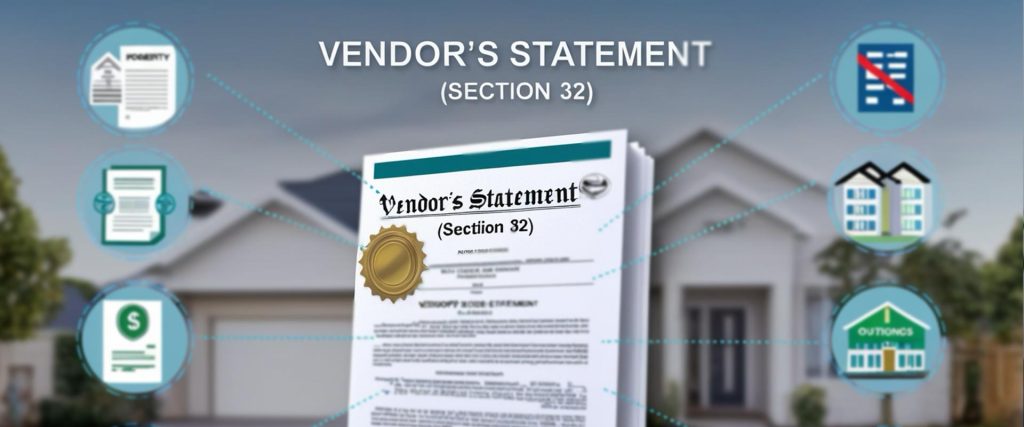Melbourne Central Conveyancing and Legal Pty Ltd
What Is a Vendor’s Statement? A Key Document in Property Sales

Introduction
If you’re buying or selling property in Victoria, one of the most important documents you’ll encounter is the Vendor’s Statement, commonly known as the Section 32 statement. This document is a legal requirement in Victoria and plays a crucial role in real estate transactions. But what exactly is a Vendor’s Statement, and why is it so important? In this blog, we’ll explore what a Vendor’s Statement is, what it includes, and why it’s essential for both buyers and sellers in property sales.
What Is a Vendor’s Statement?
A Vendor’s Statement, or Section 32 statement, is a legal document that the seller (vendor) must provide to the buyer before a contract of sale is signed. The document is named after Section 32 of the Sale of Land Act 1962, which mandates that the seller disclose specific information about the property to the buyer.
The purpose of the Vendor’s Statement is to ensure that the buyer is fully informed about any legal obligations, restrictions, or potential issues related to the property. By providing this information upfront, the seller helps the buyer make an informed decision and protects themselves from potential legal disputes down the line.
What Does a Vendor’s Statement Include?
A comprehensive Vendor’s Statement typically contains the following key elements:
1. Title Information
The title information section provides proof that the seller is the legal owner of the property and has the right to sell it. This section also discloses any encumbrances on the title, such as mortgages, liens, or charges, that may affect the buyer’s ownership of the property.
2. Zoning and Planning Information
This section details the zoning classification of the property, which determines how the land can be used (e.g., residential, commercial, industrial). It also includes any planning overlays or restrictions that may affect the property’s development potential.
3. Easements and Covenants
An easement gives someone else the right to use part of the property for a specific purpose, such as access or utilities. A covenant is a restriction on how the property can be used, such as building height restrictions. Both easements and covenants must be disclosed in the Vendor’s Statement, as they can significantly impact the buyer’s use of the property.
4. Outgoings
The outgoings section outlines any ongoing costs associated with the property, such as council rates, water rates, and land tax. This information helps the buyer understand the financial obligations they will assume once they own the property.
5. Building Permits and Warranty Insurance
If any building work has been carried out on the property within the last seven years, the Vendor’s Statement must include details of any building permits that were issued and any warranty insurance that covers the work. This is particularly important for ensuring that any construction or renovations meet legal standards and are covered against defects.
6. Owners Corporation Information
If the property is part of a unit development or apartment complex, it may be managed by an Owners Corporation (formerly known as a body corporate). The Vendor’s Statement should include details about the Owners Corporation, such as fees, rules, and any ongoing maintenance issues. This information is essential for buyers to understand their rights and responsibilities as part of the community.
7. Planning Notices
Sometimes, there may be planning notices or proposals from government authorities that could affect the property in the future. For example, a proposal to build a new road nearby or a plan to rezone the area. These notices must be disclosed in the Vendor’s Statement so that the buyer is aware of any potential changes that could impact the property’s value or use.
Why Is the Vendor’s Statement Important?
The Vendor’s Statement is a critical document in the property transaction process for several reasons:
- Legal Compliance: In Victoria, providing a Vendor’s Statement is a legal requirement. Failing to provide an accurate and complete Vendor’s Statement can result in serious legal consequences, including the buyer withdrawing from the sale or taking legal action against the seller.
- Transparency: The Vendor’s Statement ensures transparency in the transaction by providing the buyer with all the necessary information about the property. This helps to build trust between the buyer and seller and can lead to a smoother transaction process.
- Risk Mitigation: For sellers, providing a comprehensive Vendor’s Statement protects them from potential disputes or claims by the buyer after the sale. By disclosing all relevant information upfront, the seller reduces the risk of future legal issues.
How Is the Vendor’s Statement Prepared?
Preparing a Vendor’s Statement requires gathering detailed information about the property and conducting various searches. This can include obtaining title documents, zoning certificates, and information from the local council and utility providers. Given the complexity of the document and the legal requirements involved, most sellers choose to hire a conveyancer or lawyer to prepare the Vendor’s Statement on their behalf.
A conveyancer or lawyer will ensure that all necessary disclosures are made and that the document is legally compliant. They will also review the document to ensure its accuracy and completeness, protecting both the seller and the buyer.
Conclusion
The Vendor’s Statement is a key document in any property sale in Victoria. It provides essential information about the property that helps buyers make informed decisions and protects sellers from potential legal disputes. Whether you’re buying or selling property, it’s crucial to understand the importance of the Vendor’s Statement and ensure that it is prepared accurately and in compliance with the law.
At Melbourne Central Conveyancing, we specialize in preparing comprehensive and accurate Vendor’s Statements that meet all legal requirements. If you’re selling property in Victoria, contact us today to learn more about how we can assist you in preparing a Vendor’s Statement that ensures a smooth and successful transaction.
